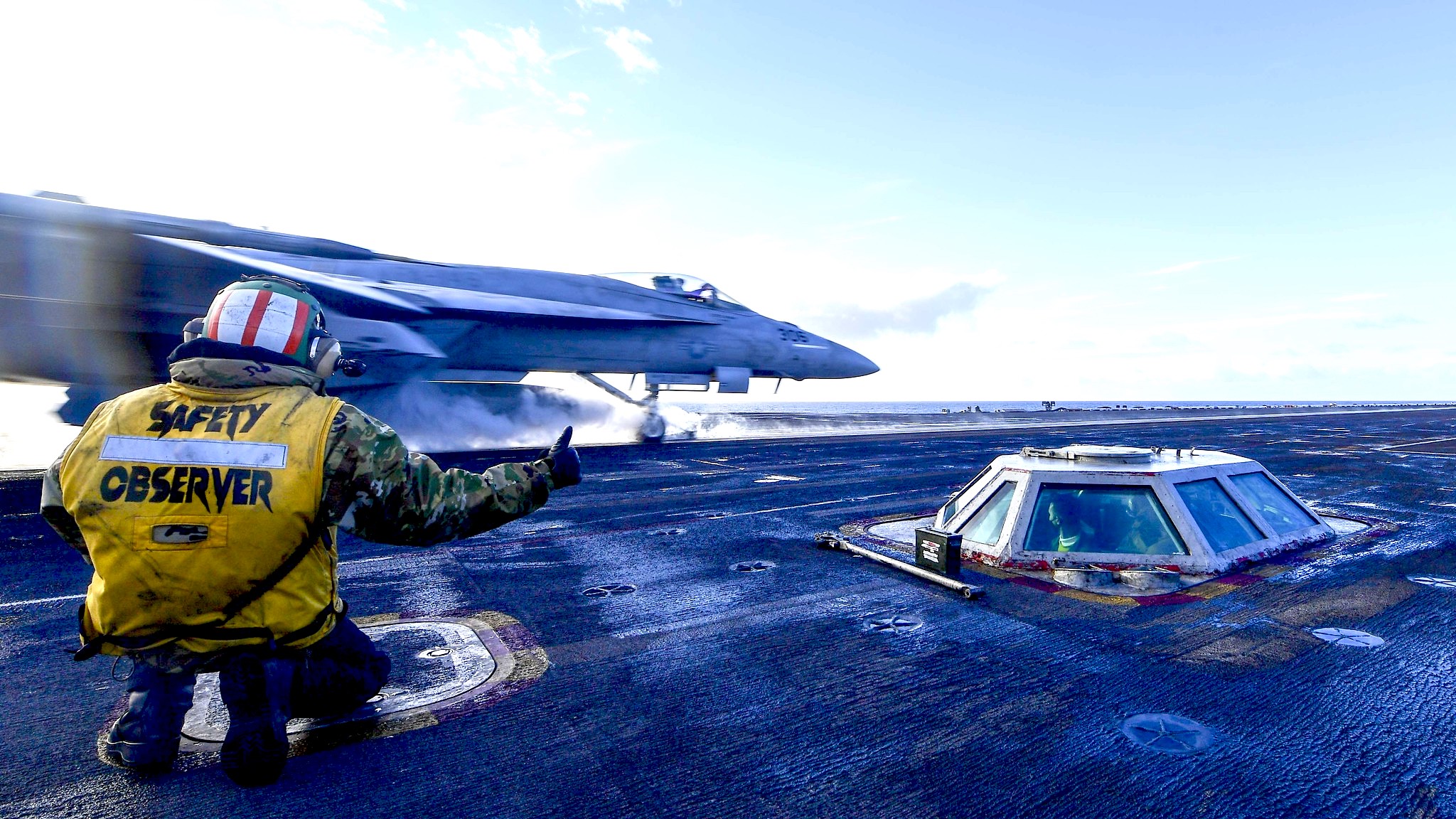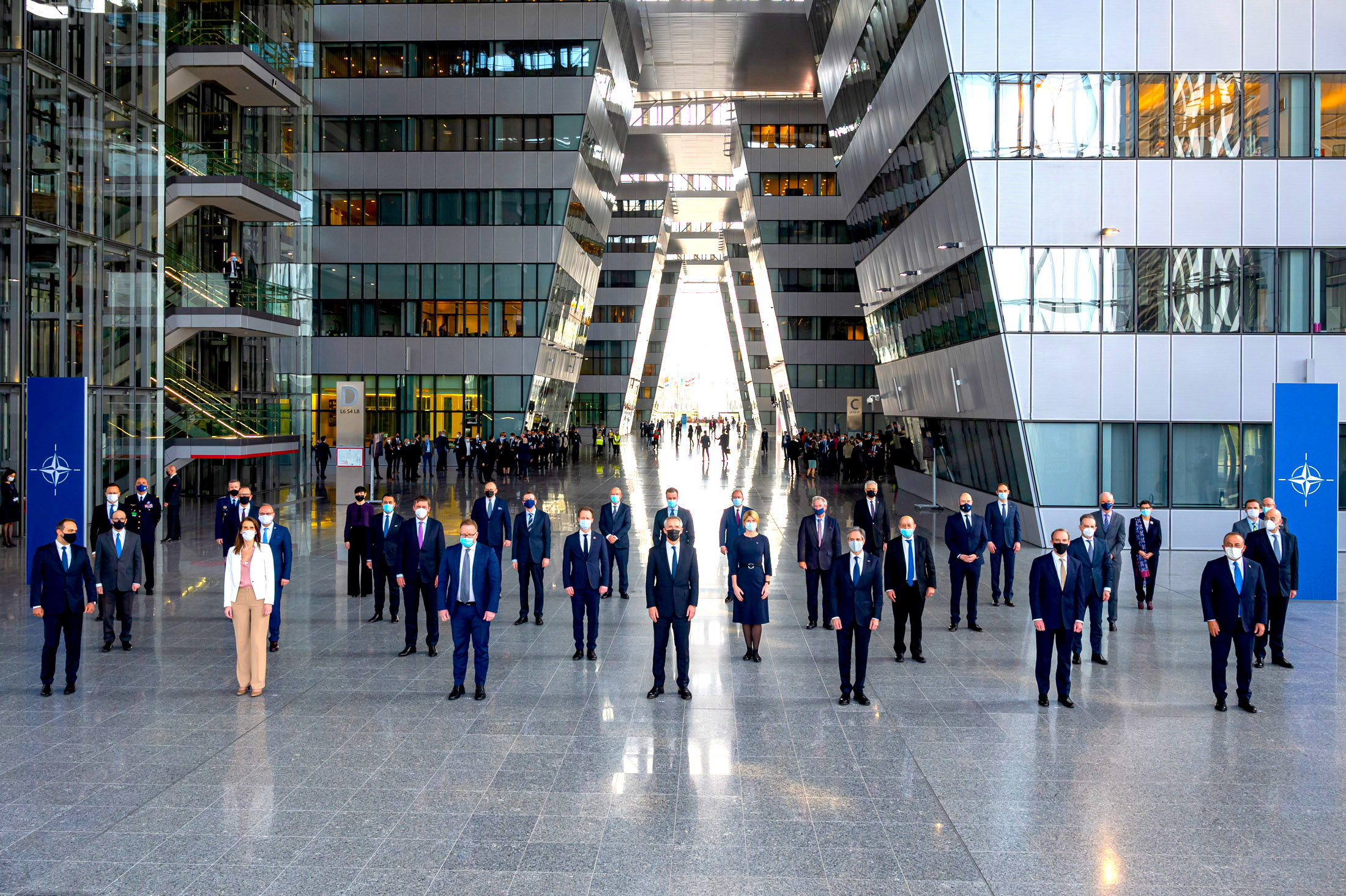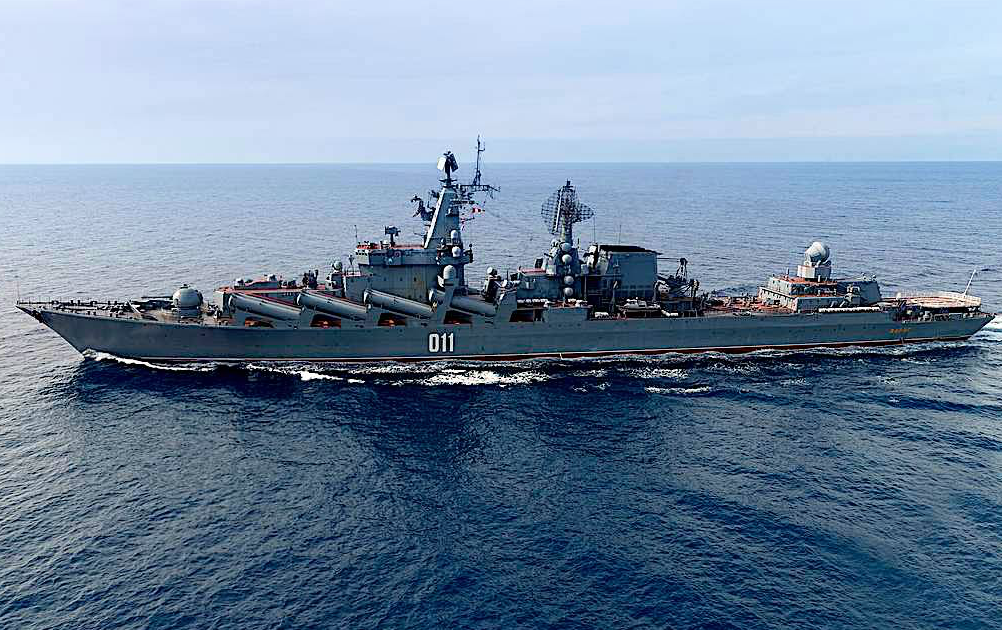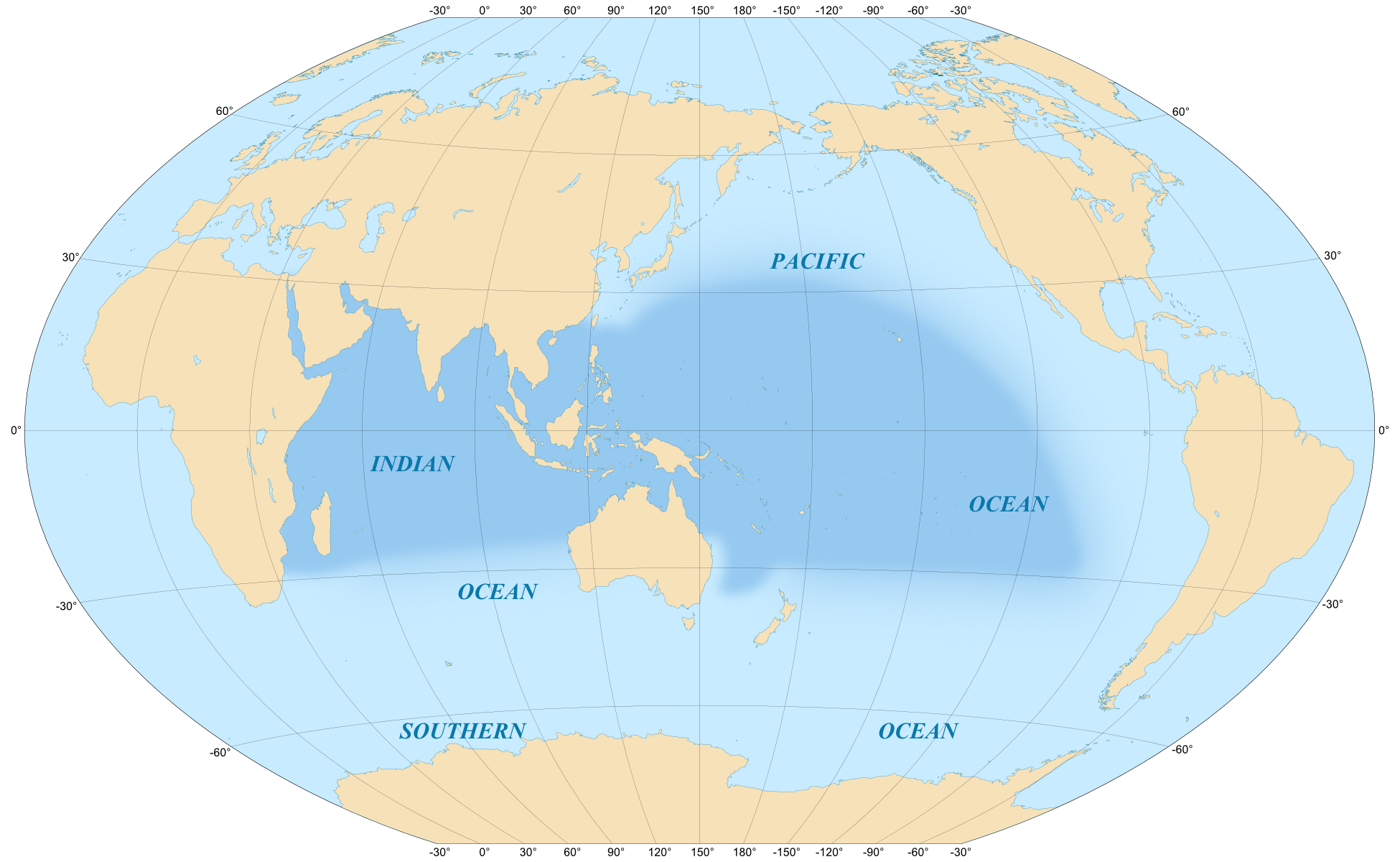Ann Wright reports on the buildup of war practices in the region, including Russia’s training at the edge of U.S. territorial waters off Hawaii and massive U.S.-Australian maneuvers underway through August.

In May, a U.S. Navy boatswain watches an F/A-18E Super Hornet launching from the flight deck of the aircraft carrier USS Theodore Roosevelt off Alaska as part of series of U.S. Indo-Pacific Command exercises. (U.S. Navy, Eduardo Torres)
 Each week the Pacific is getting even more crowded with military ships, submarines and aircraft from countries in the region and from outside. NATO countries — United Kingdom, France, Germany and the Netherlands — are sending military vessels and aircraft.
Each week the Pacific is getting even more crowded with military ships, submarines and aircraft from countries in the region and from outside. NATO countries — United Kingdom, France, Germany and the Netherlands — are sending military vessels and aircraft.
The Russian navy conducted military maneuvers off Hawai’i.
The U.S. is on the verge of creating a permanent Pacific naval task force as a part of its aggressive response to China’s naval presence in the Pacific. The largest land exercise in Asia and the Pacific is taking place in Australia with 17,000 U.S. and Australian military.
In March, President Joe Biden directed the Pentagon to establish a China Task Force to examine China-related policies and processes and give its recommendations to Defense Secretary Lloyd Austin. The creation of a Pacific Naval Task Force would allow the secretary of defense to provide more of the Pentagon’s budget for challenging China’s presence in the Pacific. The Pacific task force would also include NATO allies such as Britain and France, that have already sent their warships into the Pacific, as well as Japan and Australia.
At the recent NATO meeting in Brussels, most leaders agreed with Biden’s confrontational stance with China, declaring that Beijing is undermining global order and is a security challenge. A similar NATO naval task force, the Standing Naval Forces Atlantic, composed of six-to-10 ships, destroyers, frigates and support vessels from multiple NATO nations, has operated for decades in Atlantic waters.

NATO ministers in Brussels in March. (Estonian Foreign Ministry, Flickr, CC BY 2.0, Wikimedia Commons)
Russian War Practice Near Hawaii
It’s not only China that is causing the U.S. concerns in the Pacific. A U.S. missile defense test was delayed at the missile test facility on the Hawaiian island of Kauai in May due to the presence of a Russian surveillance ship 13 miles off the island, at the edge of U.S. territorial waters.
The Kareliya, a Russian Navy Vishnya-class auxiliary general intelligence, or AGI, ship is based in the Russian Pacific port of Vladivostok and is one of seven AGIs specializing in signals intelligence. For several weeks it sailed off the coast of Kauai, 100 miles from the massive U.S. naval facility at Pearl Harbor on the island of Oahu.
The Missile Defense Agency (MDA), in cooperation with the U.S. Navy, conducted on Kauai what it called Flight Test Aegis Weapon System 31 to demonstrate the capability of a ballistic missile defense (BMD)-configured Aegis ship to detect, track, engage and intercept a medium-range ballistic missile target with a salvo of two Standard Missile-6 Dual II (BMD-initialized) missiles.
To the chagrin of the MDA, with the Russian signals ship as a witness, the May 29 missile test eventually was carried out with ship-fired missiles but they failed to intercept a medium-range ballistic missile target.
The U.S. Pacific Fleet at Pearl Harbor made this statement at the time, saying it was
“aware of the Russian vessel operating in international waters in the vicinity of Hawai’i, and will continue to track it through the duration of its time here. Through maritime patrol aircraft, surface ships and joint capabilities, we can closely monitor all vessels in the Indo-Pacific area of operations.”
A few days later, U.S. Air Force F-22 jets made two sudden flights out of Hawai’i with the Indo-Pacific Command eventually acknowledging that “several Russian ships and aircraft” were 200 miles to the west of the Hawaiian Islands and the F-22s had been sent out to keep watch on them.
The “several ships and aircraft” turned out to be the largest Russian naval maneuvers in the Pacific since the end of the Cold War. As reported by the Honolulu Star Advertiser on June 23, prior to the meeting of the Russian President Vladimir Putin and President Joe Biden in Geneva on June 16, the Russian Ministry of Defense publicized the Russian naval maneuvers off Hawai’i as a naval and air exercise that practiced “destroying the aircraft carrier strike group of the mock enemy” and delivering a simulated strike with cruise missiles against “critically important” military infrastructure. The Russian press release described the military exercise as two detachments of ships, operating about 2,500 miles southeast of the Kuril Islands, that detected, countered and delivered missile strikes against an aircraft carrier strike group.
The missile strike practice was conducted by the flagship of the Pacific Fleet, the missile cruiser Varyag, the frigate Marshal Shaposhnikov and multiple corvettes. Twenty surface warships, including a submarine and support vessels, were involved in the exercise with 20 aircraft, including long-range antisubmarine aircraft Tu-142M3, anti-submarine aircraft Il-38, high-altitude fighter-interceptors MiG31BM, deck anti-submarine and search-and-rescue helicopters Ka-27.

Russian missile cruiser Varyag in 2016. (Vadim Savitsky/Russian Defense Ministry’s Press Office/TASS)
The deployment of Russian “Bear” bombers as part of the exercise twice resulted in missile-armed Hawaii Air National Guard F-22 fighters scrambling to possibly intercept the turboprop planes — which headed in the direction of Hawaii but never came close, according to U.S. officials. No U.S. intercepts of the Russian aircraft were made.
The two long-range Tu-142MZ anti-submarine aircraft that provided support to the exercise had flown from Kamchatka Peninsula, spending more than 14 hours in the air and covering about 10,000 kilometers during the exercise, according to the news report.
Rounding out the air component of the Russian exercise were six Il-38 and Il-38N anti-submarine aircraft that searched for and tracked submarines of the “mock enemy.” The anti-submarine aircraft were escorted by MiG-31BM high-altitude interceptor fighters of the Pacific Fleet with refueling capability provided by II-78 aircraft of the Russian Aerospace Forces.
An open-source satellite view of the Russian flotilla was taken on June 19 when it was 35 nautical miles (40 statute miles) south of Honolulu and was being escorted by three U.S. Navy destroyers and a Coast Guard cutter.
A spokesman for U.S. Indo-Pacific Command at Camp H.M. Smith in Honolulu said on June 21 that the Russian vessels operated in international waters throughout the exercise and at the closest point, some Russian ships operated approximately 20 to 30 nautical miles (23 to 34 statute miles) off the coast of Hawaii and that they were tracked very closely by U.S. forces.
US & Russian Vessels Around Hawaii
Making for a crowded area around Hawai’i, the USS Carl Vinson aircraft carrier strike group based in San Diego was operating off the east side of the Hawaiian Islands at the same time the Russian fleet was off the west side of the islands. The Carl Vinson, the flagship of the carrier strike group, conducted exercises with Carrier Air Wing 2, Destroyer Squadron 1, the guided-missile destroyers USS O’Kane, USS Howard, USS Chafee, USS Dewey and USS Michael Murphy. The Chafee and Michael Murphy are based at Pearl Harbor.
French Air Force Arrives
On Sunday, June 27, in their first visit to Hawai’i, the French government sent 170 Air and Space Force personnel, three Rafale fighter aircraft, two A330 Phenix refueling tankers and two A400M Atlas transports to Joint Base Pearl Harbor-Hickam in Honolulu for training with Hawai’i-based U.S. F-22 fighters, C-17 cargo aircraft and KC-135 refuelers. The French squadron will depart Hawai’i on July 5 for Nellis Air Force Base in Nevada for more training with U.S. military units. U.S. Pacific Air Force command emailed that “It is imperative that the U.S. accelerates change in synchronization with allies like France to ensure we are ready for the next fight.”
The British Are Coming Too

HMS Queen Elizabeth, left, with two escort vessels, off the coast of Scotland in 2017.
(Ministry of Defence)
Besides the French military aircraft arriving in the Pacific, the new British 65,000-ton aircraft carrier HMS Queen Elizabeth and its carrier group is heading for the Pacific in what is called the “most important peacetime deployment in a generation” for the United Kingdom.
British Defense Secretary Ben Wallace said on April 26 that “even as the Pacific’s importance to our future economy continues to rise — so the challenges to the freedom of navigation in that region continue to grow. Our trade with Asia depends on the shipping that sails through a range of Indo-Pacific choke points, yet they are increasingly at risk.”
HMS Queen Elizabeth, the centerpiece of Britain’s Royal Navy, departed the U.K. in May for a world voyage including stops in 40 nations and steaming through the South China Sea. Defense Minister Wallace said that while China is “increasingly assertive, we are not going to the other side of the world to be provocative. We will sail through the South China Sea. We will be confident, but not confrontational.”
Adding to the numbers of naval vessels in the crowded South China Sea will be the nine escort vessels of HMS Queen Elizabeth: destroyers HMS Defender and HMS Diamond, anti-submarine frigates HMS Kent and HMS Richmond, the Royal Fleet Auxiliary’s RFA Fort Victoria and RFA Tidespring, Dutch frigate HNLMS Evertsen and U.S. Navy destroyer USS The Sullivans.
US & the ‘International Rules-Based Order’
The State Department said the United States, which has maintained what it calls the “international rules-based order” in the Pacific since the end of World War II, is “committed to upholding a free and open Indo-Pacific in which all nations, large and small, are secure in their sovereignty and able to pursue economic growth consistent with international law and principles of fair competition.” In 2019, the U.S. Department of Defense wrote in its strategy document that the Indo- Pacific region is the single most consequential region for America’s future.
Admiral Phil Davidson said on April 30 when he relinquished leadership of the massive U.S. Indo-Pacific Command, “Make no mistake, the Communist Party of China seeks to supplant the idea of a free and open international order with a new order — one with Chinese characteristics — where Chinese national power is more important than international law.”
Davidson added that strategic competition in the Indo-Pacific “is not between two nations, it is a contest between liberty — the fundamental idea behind a free and open Indo-Pacific — and authoritarianism, the absence of liberty.”
China Responds
On May 27, at a China Ministry of National Defense press conference, Senior Colonel Tan Kefei said America keeps “stepping up military deployments in the Asian Pacific region, frequently conducts close-in reconnaissance against China, and even deliberately initiates dangerous circumstances between Chinese and U.S. military aircraft and vessels.”
He added that a strategy emphasizing military presence and military competition “will only heighten regional tensions and undermine world peace and stability. No strategy should instigate countries to establish selective and exclusive military alliances, or to create a ‘New Cold War’ of confrontational blocs.” In relation to Taiwan, Tan said, “there is only one China in the world, and Taiwan is an integral part of China,” and that currently China-Australia relations “face serious difficulties.”
G7 & Quad Support Status Quo on Taiwan
The Group of Seven, or G7 —made up of leaders from Canada, France, Germany, Italy, Japan, the United Kingdom and United States —said on June 13 that, “We underscore the importance of peace and stability across the Taiwan Strait,” adding that “we remain seriously concerned about the situation in the East and South China Seas and strongly oppose any unilateral attempts to change the status quo and increase tensions.”
Three months earlier, on March 12, the first leaders’ meeting of the Quadrilateral Security Dialogue, or “Quad” — the United States, Japan, Australia and India — issued a statement saying they are:
“united in a shared vision for the free and open Indo-Pacific…We support the rule of law, freedom of navigation and overflight, peaceful resolution of disputes, democratic values and territorial integrity.”
Largest Land-War Maneuvers in Region
The largest land war practice in the region, the U.S.-Australian war maneuvers Talisman Sabre 2021 began in June in Australia. Scaled down from 30,000 due to Covid, over 17,000 military personnel from the U.S., Canada, Japan, Republic of Korea, New Zealand and the U.K. will conduct war maneuvers including combined Special Forces operations, parachute drops, amphibious (marine) landings, land-force maneuvers, urban and air operations and the coordinated firing of live ammunition from late June until mid-August. France, India and Indonesia will participate as observer nations. The U.S.-Australian hypersonic weapon, capable of flying at speeds greater than five times the speed of sound (Mach 5), may be tested during Talisman Sabre 2021 at the Australian rocket range near the town of Woomer, South Australia.
In one month alone, this June, the U.S. IndoPacific Command military forces participated in over 35 war maneuvers with other countries. Read more about the war preparations with these countries here.
Ann Wright is a 29-year US Army/Army Reserves veteran who retired as a colonel. She is also a former U.S. diplomat who resigned in March 2003 in opposition to the war on Iraq. She served in Nicaragua, Grenada, Somalia, Uzbekistan, Kyrgyzstan, Sierra Leone, Micronesia and Mongolia. In December 2001 she was on the small team that reopened the U.S. embassy in Kabul. She is co-author of Dissent: Voices of Conscience.


If Russia and PR China were to become as submissive as Britain and Japan, the US constant warfare state would still need to invent enemies. We Americans can’t live without a cosmic enemy and endless killing of “lesser breeds outside the law”.
As a former Navy enlisted man that deployed on two occasions to the Western Pacific I can tell you that the USA doesn’t give a damn about “freedom of navigation” and all those euphemisms they throw about. All they care about is domination and the extraction of raw materials from weaker nations. China has every right to defend their territorial waters in the South China Sea and China has not invaded anyone (they had a border skirmish with Vietnam roughly 40 years ago). The USA wants to keep the planet under their military boot and that is why they spend over 700 billion dollars a year for while ignoring the well being of us citizens at home (police racism, lack of health care, homelessness , low wage jobs with little or no benefits and rampant student and credit card debt to name a few). The Chinese, Russian and other peoples of the world know better that to follow the path of the USA, they have rebuilt their economies and military to counter USA bullying and China has played by the WTO rules and outperformed the USA at their own Capitalist game (a result of a superior educational system and the long term planning of the CCP). Who died and left the USA in charge of the planet? In the article it was stated that “united in a shared vision for the free and open Indo-Pacific…We support the rule of law, freedom of navigation and overflight, peaceful resolution of disputes, democratic values and territorial integrity.” The rule of law by a country (NATO Included) that has invaded, sanctioned to death the populations of dozens of countries and overturned democratic held elections all over the planet? The same country that nuked Japan to show the former Soviet Union that it had the ultimate weapon and wasn’t afraid to use it and has refused to state that it will not be the first to strike with nuclear weapons when the Soviets and Chinese stated publicly that they will not be the first to strike? The USA and NATO countries are on their way out of global dominance but they are in denial and their manifest destiny blinds them to global realities that they refused to comprehend. My father, brother and me served in the military but none of my children have as I now understand that I was a tool of Empire and democratic denial of the rest of the world.
Interesting Read. I guess two questions need answers 1 Can claimed unstoppable hypersonic missiles Sink carriers. 2 Could China successfully nuke enough USA cities to deter a USA nuclear attack.
1. Highly technological question. I would guess yes.
2. How many lives, civilian lives, are citizens of USA ready to sacrifice in the name of Freedom in Hong Kong, Taiwan or Solomon Islands? 1000? 100,000? 500,000? I do not know about any polls on the topic, so let’ say that this is an open question.
Relax. At their recent meeting Biden and Putin had agreed that nuclear war cannot be won and must never be fought. This meant that even conventional wars between nuclear-armed nations could never be fought, for no nation would lose any such war without resorting to nuclear weapons. And all countries know it’s true: anything from hurling 50 to 200 megatonage weapons from each side would more or less make living very, very difficult, if not impossible. At the very least, all the warring empires would end, and that surely is a blessing to smaller nations that somehow survive the nuclear winter. So let those who want a war go ahead. The world can’t be worse than having bullies – from any side – threatening everyone else every minute of their lives. People from Latin America to those former inhabitants of Diego Garcia would celebrate with songs and dances. God bless them!
Pre WW1 type imperial willywaving all justified by copious pompous bullshit.
The only “international rules-based order” is that established by the UN Charter. Everything else is US bluster.
The world is in mortal danger until the US gives up its hegemonic aspirations.